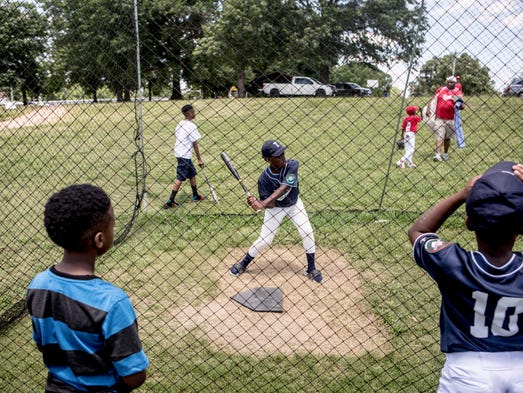Categories
For former amateur player, rekindling black youth’s love for baseball is a top mission – The Commercial Appeal

Leonard Draper, a former semi-pro Negro League player here, talks to a young softball player about the upcoming school year and baseball.
Tonyaa Weathersbee/The Commercial Appeal
Leonard Draper was a child during the waning days of Negro League Baseball. So, he didn’t get to play for the Memphis Red Sox or the Kansas City Monarchs – Jackie Robinson’s first team.
But he got close enough to the magic of it all to build his own baseball dreams.
“We used to walk over to Martin Stadium, which was on Crump Boulevard, and I would go in and we would be bat boys for those Negro League teams,” said Draper, who is now 77.
“People would pick me up and I’d be a bat boy for the [Cleveland] Buckeyes and the Memphis Red Sox…we were in awe of all those guys playing with the Red Sox…they would barnstorm through Memphis, and we would work and sell souvenirs, because for us, baseball was all we could do during the summer.”
Draper’s passion for baseball is splayed all over the pages of Ernest Withers’ book, “Negro League Baseball,” where he is pictured at the stadium in a suit as a spectator, in his high school baseball uniform, and in other shots.
He later played for the Federal Compress Blues, one of Memphis’ amateur black baseball league teams. He was also inducted into the Memphis’ Amateur Sports Hall of Fame for baseball in 1988.
But nowadays Draper, who is probably best known for his involvement with University of Memphis basketball – he was a mentor to former Tiger coach Larry Finchand his grandson, Trey, played basketball there – preserving his baseball legacy may lie with people like Beatrice Bursi.
That’s because like Draper, Bursi wants to rekindle a passion for baseball among African-American youth – a passion that has waned to the point where African-Americans comprise only 7 percent of major league baseball players.
That’s the lowest percentage of black participation since 1958 – 11 years after Robinson broke the MLB color barrier – and ushered in the crumbling of other racial barriers.
Bursi recently brought five of her 14 grandchildren to Jesse Turner Park to participate in a series of softball games coordinated by Tri-State Youth Baseball Academy.
“My 10-year-old loves this. He’s been playing for five years,” Bursi said. “Five are playing right now… These kids are enjoying it, and every year, I see more and more new teams come in.
“They love this sport, and I just wish we could get more of them interested in it.”
That’s the kind of news that Draper, treasurer for the 10-year-old organization, loves to hear.
And he loves to hear it not simply because the sight of youths filling the park reminds him of his younger days, but because they also give him hope that at some point, more African-American youths will want to play not only because of the potential rewards, but because of the connection to their history.
“I started, when I was about 7 or 8 years old, playing in Foote Homes Park,” Draper said. “Jackie Robinson influenced us all, because back then, we weren’t into basketball and football…
“Later, I started playing in high school, and we started a semi-pro league here…from 1960 on, I began to play a little baseball with the men…”
The “men” was the Compress Blues – which Draper played for from 1961 to 1971. He joined that team two years after he tried out for the Detroit Tigers in 1958 while visiting his uncle in that city over the summer.
He didn’t make it.
“I didn’t make the team, but the experience was good for me,” Draper said. “I was in Detroit, and I worked at the youth centers, so that was good.”
Over the years, Draper’s baseball experiences have shaped his love for youths – he volunteers as a lunchtime monitor at Westhaven Elementary School – and his determination to see the sport reclaim its place in their lives.
But, he admits, it’s tough.
Basketball and football have, over the years, captured the imaginations of African-American youths to the point where many ascribe wealth and fame only to those sports. Yet nothing could be further from the truth, Draper said.
“Our HBCUs have openings in baseball, and that’s why we’re trying to get our kids back into it,” he said. “There are some major salaries being paid in baseball…
“I think we lost it because we didn’t have enough people willing to devote their time, and it takes a lot of discipline and practice time…I would also like to see more baseball camps, and not as many basketball camps.”
There’s another problem, though.
Baseball requires mitts, bats and balls. Many don’t have the money to play – and that’s a situation that Tony James, chairman of the baseball academy, has been struggling with.
An investment banker, James sponsors six teams on his own – and he hopes to get more corporate investors – as does Draper.
Said Draper: “We’re just trying to convince our kids there’s a future in baseball for them, because everybody can’t be a great basketball player, but with baseball, there’s a ticket for you to go to college.”
Bursi already knows this.
“One [of her grandchildren] just graduated from high school, and has a full scholarship to Jackson State for baseball,” Bursi said.
The academy may have a winning combination here.
Draper brings his experiences and his historical memory of baseball’s importance to African-Americans; of how Robinson’s excellence in America’s pastime began to erode the racist foundations on which the society was built.
And Bursi, by bringing her grandchildren out to play baseball and by encouraging others to do so, helps to ensure that at some point, more black youths will not only be claiming scholarships and careers, but also reclaiming their forebears’ place in history.
“My grandfather played with the Negro Leagues,” said Bursi, “He was in his 80s, and he was watching baseball, the World Series, and I asked, ‘Granddad, what are you doing?’
“And my mom said, ‘You know he played.’”





















